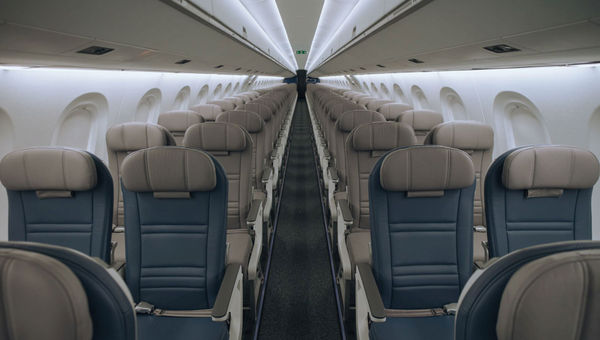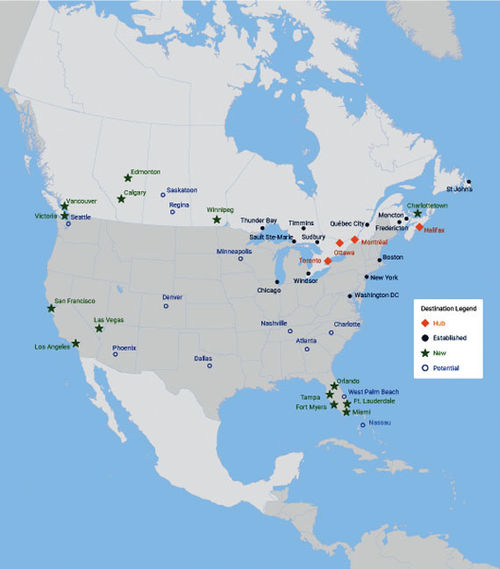Canada's Porter Airlines put its first jets into operation in early 2023, and the carrier has already undergone a substantial transformation since then.
Porter had been an all-propeller-plane airline serving Eastern Canada and four U.S. Northeast cities from a hub at Toronto's secondary Billy Bishop Airport. It now flies to five destinations in Western Canada and to five destinations in Florida from Toronto's primary Pearson Airport. The airline has also begun flying longer routes out of a new base in Ottawa.

Kevin Jackson
Chief commercial officer Kevin Jackson says the expansion has just begun.
"Porter will certainly be positioning itself as the No. 2 carrier in the Canada domestic market in the next five years," he said.
In order to profitably sustain such growth, however, the carrier must navigate the task of competing with dominant market leader Air Canada, even as it takes on a more complex business model and grows into numerous new markets.
At the core of Porter's new business model is its new fleet of 132-seat Embraer E195 E2 aircraft. By year's end, Porter will have 29 E2s to accompany its 29 Bombardier Q400 propeller planes. The airline has another 46 E2s on order for delivery by 2026.
The E2 has a range of approximately 3,000 miles, which is more than twice the range of the Q400. That, coupled with a seat count that is 54 higher than its Q400s, enabled Porter to begin service from Toronto to Vancouver and to Edmonton and Calgary in Alberta last winter.

The interior of a Porter Airlines Embraer E195 E2 plane. Photo Credit: Porter Airlines
More routes have followed, including flights from Toronto to the Florida destinations of Orlando, Miami, Fort Myers, Tampa and Fort Lauderdale over the past two months as well as new flights from Ottawa.
This month, Porter will fly more than twice as many domestic seats as it did last January, an increase that has made it Canada's third-largest domestic carrier behind WestJet and Air Canada, Cirium flight data shows. In the Canada-U.S. market, Porter has also doubled its seat offering year over year to 75,000 seats -- not too far behind American Airlines' seat count of 105,000.
This month will also see the launch of Porter service between Toronto and Los Angeles and San Francisco, with Toronto-Las Vegas coming in March. Porter hopes to bolster sales on those first two West Coast routes via a new codeshare and mileage partnership with Alaska Airlines.
Jackson said the airline will add more routes and frequencies to Florida next year. And within the U.S., the carrier has tabbed Charlotte, Nashville, Atlanta, Minneapolis, Dallas, Denver, Phoenix, Seattle and West Palm Beach, Fla., as potential destinations.
However, Jackson said Porter's U.S. network ultimately will be shaped by partnerships, including potential new ones with Alaska as well as an older partnership through Boston and Newark with JetBlue.
"There are opportunities to tap into partnerships with U.S. airlines, which would allow Porter to be a larger player in the U.S. than we could be on our own," he said.

Porter has ambitions to expand to several more U.S. cities, including Atlanta, Nashville and Denver.
American is one obvious option. The transborder partnership of Air Canada and United is the market behemoth, comprising 56.2% of scheduled January seats. Delta partners with WestJet for a combined 21.7% of the market. But American doesn't have a Canadian partner.
Porter is also hoping to bolster traffic, both within Canada and across the border, by offering European connectivity via a proposed joint venture with transatlantic leisure operator Air Transat, which flies most prominently from Montreal and Toronto Pearson.
"Everybody wants to grow. The economics favor growth," said airline industry analyst Bob Mann of R.W. Mann & Co. "But there are ways of growing that don't make any sense."
The Air Transat plan is one element of Porter's expansion strategy that has Mann skeptical. Porter flies a denser schedule of frequencies to cater to a target market of economy business travelers than does Air Transat, which is part of a broader tour operator brand.
Other issues of concern, Mann said, include taking on the extra expense of flying two aircraft types while moving into new airports and destinations.
"I just don't understand why they think this is a winning proposition," he said.
Jackson said Porter's transformation is off to a smooth start.
"When we launched this growth plan, we knew we had an advantage over all-new airlines because of our established customer base," he said. "We had millions of customers who already knew the Porter brand and were already flying it within our network."